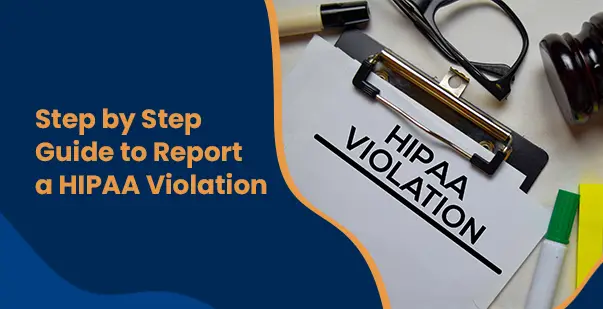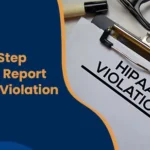How to Report a HIPAA Violation: Your Practical Guide for 2026

October 10, 2025
A July 2025 report from the Center for Data Compliance shows HIPAA breaches climbed by nearly 17% every month since last summer. That means more patient records – and more privacy – are at risk than ever before. For example, in early 2025, a breach at a regional hospital in Texas exposed the records of more than 50,000 patients, showing how even mid-sized organizations are being hit by escalating cyberattacks.
If you’re a working professional in healthcare, you need to know how to navigate the HIPAA violation reporting process. This guide breaks it down, giving you real-world steps on where and how to file a complaint, so you can take action and help protect sensitive patient data.
A December 2024 study by the University of Cincinnati Law Review found that it’s usually up to individuals to spot and report HIPAA violations. That means some breaches never get the attention they deserve, often slipping through the cracks.
What Counts as a HIPAA Violation in 2025?
HIPAA, or the Health Insurance Portability and Accountability Act, was designed to keep patient health information safe and private. But even with laws in place, violations still pop up – and knowing how to report a HIPAA violation is crucial for anyone in healthcare.
You’ll want to spot what violates HIPAA rules. A violation could look like unauthorized access to protected health information (PHI), sharing patient details without consent, mishandling electronic PHI (ePHI), or not telling patients about a breach within the allowed timeframe.
Timely Reporting Requirements
According to 2025 CMS (Centers for Medicare & Medicaid Services) guidelines, providers must alert the authorities about most breaches as soon as possible – but never later than 60 days from finding out. If fewer than 500 patients are affected, providers report the breach to the Department of Health and Human Services (HHS) within 60 days of the end of the calendar year. And don’t forget: patients and, at times, the local media need notifications too. For instance, a dental clinic that mistakenly mailed 200 patient billing statements to the wrong addresses must still notify patients right away but can wait until year-end to file the summary with HHS.
To start the HIPAA violation reporting process, review what happened, gather any documents, and check your workplace’s internal procedures. If you see or hear about something suspect, talk to your privacy officer or reach out to the HHS Office for Civil Rights (OCR).
Jumping on issues quickly isn’t just a legal step – it shows commitment to patients and doing the right thing. For a deep dive, take a look at the full CMS resource: https://www.cms.gov/files/document/mln909001-hipaa-basics-providers-privacy-security-breach-notification-rules.pdf.
Here’s a simple trick: set up a checklist of common HIPAA violations specific to your job. It gives you a quick reference so you don’t second-guess what counts as a breach when the pressure’s on.
Who Should File a HIPAA Violation Report?
The HIPAA violation reporting process is something anyone – staff or patient – can start if privacy is at risk. The big question is: where to report HIPAA violations so they actually get addressed?
Most HIPAA complaints are handled by the U.S. Department of Health and Human Services’ Office for Civil Rights (OCR), the agency responsible for enforcing HIPAA. In 2024, a patient filed directly with OCR after overhearing hospital staff discussing another patient’s diagnosis in a crowded waiting room — OCR launched an investigation that led to corrective action. Still, most hospitals and clinics want you to use their internal reporting forms first. These forms keep a record of what happened, who was involved, and when it occurred.
When to Report Internally or to OCR
If your organization’s privacy officer doesn’t act or minimizes your concern, you’re not stuck. You can take your HIPAA complaint directly to the OCR. They offer an online portal, but you can also mail, email, or fax your report. When you fill out the HIPAA complaint form, you’ll need:
- Details about yourself (the complainant)
- The covered entity or business involved
- A clear description of what happened
- Any evidence or documents backing your claim
Hang on to copies for your own records. OCR might follow up and ask for more info, and a complete form speeds things along. Remember: HIPAA needs everyday people to speak up – reporting isn’t just allowed, it’s encouraged. For tips or to start a complaint, check out the official HHS complaint site: https://www.hhs.gov/hipaa/filing-a-complaint/index.html.
Quick tip: Before you file anything, jot down a timeline of events as best you remember. Fresh notes now mean fewer hazy details later – and they might give investigators exactly what they need.
| Step | What to Do | Details Needed |
| 1.0 | Report internally at your workplace (preferred first step) | Fill out internal reporting form with incident details, involved parties, and timing |
| 2.0 | Contact the Privacy Officer or Compliance Department | Share what happened and provide any supporting documents you can |
| 3.0 | File a HIPAA complaint with the Office for Civil Rights (OCR) | Supply your details, the covered entity’s info, a description of the violation, and evidence (save copies for your records) |
How Do You Actually Report a HIPAA Violation?
If you’re wondering how to report a HIPAA violation, it helps to know what channels are open to you and how to use them.
Your organization’s Privacy or Compliance Office is often the first stop. These experts know the policies and can review your concerns while keeping things confidential. Many workplaces offer anonymous reporting options, allowing staff to speak up without fear of retaliation. For example, many large hospital systems have a 24/7 compliance hotline where staff can leave anonymous messages that go directly to the compliance team.
When Internal Reporting Isn’t Enough
Sometimes, internal reporting isn’t the final answer – especially when an issue is widespread or goes ignored. In those cases, head straight to the HHS OCR. Their portal is secure and lets you attach supporting files right to your HIPAA complaint form.
One twist: if your issue involves a consumer health app rather than a hospital or doctor’s office, the Federal Trade Commission (FTC) may oversee the process. Say you discover a mental health app sharing user mood-tracking data with advertisers — that falls under FTC oversight rather than OCR. The legal landscape is changing fast, so knowing both your local and federal options matters.
To boost your report’s success, always keep key proof:
- Emails and written communication
- Screenshots or photos
- Any internal reporting forms or incident notes
These will back you up if OCR or any other federal agency needs to dig deeper.
Don’t forget: If your workplace has a whistleblower or compliance hotline, use it. Hotlines are designed to offer anonymity, and sometimes tips get faster attention through those channels.
Where Should You Send Your HIPAA Complaint, and What Comes Next?
Timing is everything when you report HIPAA complaints. Under 2025 CMS rules, you have just 60 days to notify authorities and patients after a breach is uncovered – no excuses for missing that window.
For small breaches (under 500 folks affected), an annual summary goes to HHS, still with zero wiggle room on the deadline. Timely reporting isn’t red tape; it helps stop more harm and builds back trust.
Steps Right After Reporting
Missed deadlines mean more than fines – they invite extra scrutiny and can hurt your workplace’s reputation. To avoid these headaches:
- Use an immediate risk assessment, per 2025 HHS guidance
- Document timelines in your HIPAA policies so everyone knows what to do
- Prioritize reporting right away – waiting only increases risk
Prompt reporting also helps patients act — such as monitoring their credit or updating passwords. And when in doubt, report sooner rather than later. In today’s world, slow reporting equals real risk for your organization and your patients.
Small hack: Set calendar reminders for HIPAA deadlines. If reporting isn’t your day job, a simple Google Calendar alert can save you from missing critical timelines under the law.
What Happens After a HIPAA Violation Is Reported? Timelines and Next Steps
The HIPAA violation reporting process is evolving, especially as more health data moves online. With breaches jumping over 16% each month since last year, it’s clear the status quo isn’t enough.
Organizations must now sharpen their privacy safeguards, keep risk assessments current, and train all staff – including community partners – with up-to-date, culturally aware materials (thanks to new recommendations from CMS and HHS).
Keeping Up with Changes
Smart organizations make clear incident response plans so every employee knows how to recognize and report a HIPAA violation – internally and, when needed, externally through the OCR. Regular training helps staff:
- Spot and document breaches
- Fill out HIPAA complaint forms correctly
- Understand their responsibility to report right away
Use digital tools wisely, but be sure they follow HIPAA standards, from records to emails. After every incident, run a debrief to see what worked and where you can improve. CMS and HHS point to this feedback loop as a key part of compliance for 2025. Putting education, better procedures, and technology together helps keep patient privacy strong and encourages a culture where everyone feels responsible for protecting health information.
Here’s something often skipped: ask your privacy officer for a quick, informal huddle after incidents to talk through what worked and what didn’t. Gathering insights when memories are fresh builds a stronger response next time around.
Conclusion
Taking action after a HIPAA violation isn’t just about following the law – it’s how you protect patient trust and keep healthcare safe. Learn what’s required, stick to reporting deadlines, and use the right channels if something feels off. New threats come fast, so keep training your staff and updating internal policies. Whether you’re a provider, administrator, or patient, you have a stake in keeping information safe. If you spot a breach, use what you’ve learned here, act quickly, and take the lead on patient privacy – it starts with you.
FAQs
Q: Where do I start with how to report a HIPAA violation?
A: To begin with how to report a HIPAA violation, you should file a complaint directly with the Office for Civil Rights (OCR) at the Department of Health and Human Services. Use the official HIPAA complaint form on their website.
Q: What is the HIPAA violation reporting process timeline?
A: Healthcare providers must report most breaches as part of the HIPAA violation reporting process within 60 days of discovery. For smaller breaches under 500 patients, submit your report to HHS each year.
Q: How can individuals report HIPAA complaints to authorities?
A: Individuals report HIPAA complaints by submitting a formal complaint form to OCR. This complaint-driven process means action happens only once OCR receives a report about suspected HIPAA violations.
Q: What details do I need for the HIPAA complaint form?
A: Provide names, dates, and details about the suspected breach when using the HIPAA complaint form. Make your report as specific as possible to help authorities understand the incident and take the right steps.





